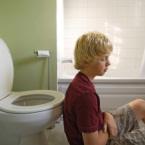 How do I know if my child is constipated?
How do I know if my child is constipated?
Bowel patterns vary in children as they do in adults. Because of this, it is sometimes difficult to tell if your child is truly constipated. One child may go two or three days without a bowel movement and still not be constipated, while another might have relatively frequent bowel movements but have difficulty passing the stool. Or a child’s constipation may go unnoticed if he passes a small stool each day, while a buildup of stool develops in his colon. In general, it is best to watch for the following signals if you suspect constipation.
-
In a newborn, firm stools less than once a day, though this can be normal in some exclusively breastfed infants
-
In an older child, stools that are hard and compact, with three or four days between bowel movements
-
At any age, stools that are large, hard and dry, and associated with painful bowel movements
-
Episodes of abdominal pain relieved after having a large bowel movement
-
Blood in or on the outside of the stools
-
Soiling between bowel movements
Causes
Constipation generally occurs when the muscles at the end of the large intestine tighten, preventing the stool from passing normally. The longer the stool remains there, the firmer and drier it becomes, making it even more difficult to pass without discomfort. Then, because the bowel movement is painful, your child consciously may try to hold it in, making the problem still worse.
The tendency toward constipation seems to run in families. It might start in infancy and remain as a lifetime pattern, becoming worse if the child does not establish regular bowel habits or withholds stool. Stool retention occurs most commonly between the ages of two and five, at a time when the child is coming to terms with independence, control, and toilet training. Older children may resist having bowel movements away from home because they don’t want to use an unfamiliar toilet. This, too, can cause constipation or make it worse.
If your child does withhold, he might produce such large stools that his rectum stretches. Then he may no longer feel the urge to defecate until the stool is too big to be passed without the help of an enema, laxative, or other treatment. In some of these cases, soiling occurs when liquid waste leaks around the solid stool. This looks like diarrhea or soiling on the child’s underpants or diaper. In these severe cases, the rectum must be emptied under a physician’s supervision, and the child must be retrained to establish normal bowel patterns. Consulting a pediatric gastroenterologist may be necessary.
Treatment
Mild or occasional episodes of constipation may be helped by the following suggestions.
Constipation due to breast milk is unusual, but if your breastfed infant is constipated, it is probably due to a reason other than diet. Consult your doctor before substituting formula for breast milk. (Keep in mind that the American Academy of Pediatrics recommends breastfeeding and avoiding cow’s milk for the first twelve months of life.)
For infants, ask your pediatrician about giving small amounts of water or prune juice. In addition, fruits (especially prunes and pears) can often help a constipated infant.
For a toddler or older child who is eating solid foods and has problems with constipation, you may need to add high-fiber foods to his daily diet.
These include prunes, apricots, plums, raisins, high-fiber vegetables (peas, beans, broccoli), and whole-grain cereals and bread products. At the same time, cut back on foods such as rice, bananas, and cereals or breads that are not high in fiber. Increasing the daily water intake also may help.
In more severe cases, your pediatrician—alone or in consultation with a pediatric gastroenterologist—may prescribe a mild laxative or enema. Follow such prescriptions exactly. Although some newer laxatives are over the counter and simpler to use than these products used to be, never give your child a laxative or other types of stool-loosening or -softening medications without first consulting with your doctor.
Prevention
Because each child’s bowel patterns are different, become familiar with your child’s normal bowel patterns. Make note of the usual size and consistency of her stools. This will help you and your pediatrician determine when constipation occurs and how severe the problem is. If your child doesn’t have normal bowel movements every few days, or is uncomfortable when stools are passed, she may need help in developing proper bowel habits.
You can. . .
-
Encourage your child to drink plenty of water and eat more high-fiber foods.
-
Help your child set up a regular toilet routine.
-
Encourage your child to be physically active. Exercise along with a balanced diet provides the foundation for a healthy, active life.
If you are concerned about your child’s bowel movements, talk with your pediatrician. A simple change in diet and exercise may be the answer. If not, your pediatrician can suggest a plan that works best for your child.
Source: https://www.healthychildren.org July 9, 2013




Leave A Comment